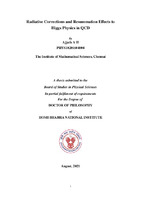- DSpace Home
- →
- IMSc Theses/ Dissertations
- →
- IMSc Theses/ Dissertations
- →
- View Item
JavaScript is disabled for your browser. Some features of this site may not work without it.
| dc.contributor.author | Ajjath, A. H. | |
| dc.date.accessioned | 2021-09-20T08:24:20Z | |
| dc.date.available | 2021-09-20T08:24:20Z | |
| dc.date.issued | 2021 | |
| dc.date.submitted | 2021 | |
| dc.identifier.uri | https://dspace.imsc.res.in/xmlui/handle/123456789/568 | |
| dc.description.abstract | The thesis comprises a selection of published works and preprints that provides a com- prehensive picture of higher order computations of physical observables at LHC. A condensed outline of the thesis is as follows. In chapter 2, we start with a brief overview of the basic principles of QCD and a discussion on methods to compute higher order corrections in perturbative QCD. We also review a framework to compute threshold corrections in great detail, which will play a notable role in our later results. In chapter 3, we discuss the NNLO computation of di-Higgs productions in the bottom quark annihilation channel. This production channel is a valuable avenue to investigate the trilinear coupling and Higgs potential, which is one of the significant challenges in the next phase of LHC. At NNLO, two classes of diagrams contribute – vertex type diagrams and t- and u- channel ones. For the computations, we use in-house routines based on FORM and Mathematica packages. Since the complete result of t- and u- channels are challenging (at present), we compute them at the SV approximation. Numerical analysis at LHC energy illustrates the reliability of our predictions. The state-of-the-art QCD corrections have reached such accuracy that requisites the in- clusion of precise predictions of mixed QCD-EW theory. This possibility is explored in chapter 4 for the bottom quark induced Higgs boson productions. Since the computation of complete EW corrections is more involved, as a first step, we compute all the QED corrections up to second order in the coupling constant α e , taking into account the non-factorizable or mixed QCD-QED effects through α s α e corrections. The computation involves dealing with QED soft and collinear singularities resulting from photons and massless partons, in addition to the QCD ones. We systematically investigate the structure of QCD and QED IR singularities up to second order in their couplings, taking into account the interference effects. In the process, we obtain the mass anomalous dimension and renormalization constant of Yukawa coupling as a bonus point. We also discuss a set of rules which connects the QCD, QED and mixed QCD-QED results. In chapter 5, we discuss the threshold corrections for a differential rapidity observable associated with the Higgs production. In particular, we address the higher order QCD corrections to this observable for generic n-colorless final states. The formalism is based upon the collinear factorization of differential scattering and RG invariance. The soft part remains similar to Sudakov-type processes, while for the virtual corrections, the kinematic dependence is much more involved. In addition to the threshold rapidity corrections, we discuss a framework to resum the threshold logarithms in rapidity variables. In the last chapter 6, our concern is to extend the threshold framework to include the next- to-threshold or next-to-SV corrections, which attracted considerable attention in recent time. While SV singular structure dominates, the next-to-SV ones are also large and pro- duce numerically sizeable corrections. Hence computing them in the absence of complete result at a given order is essential in precision studies. In this context, we propose a frame- work with the logic of IR factorization and RG invariance. We show that similar to SV the next-to-SV logarithms also exhibit an all order perturbative structure. This idea enables us to propose a formalism to resum certain next-to-leading power logarithms, which is the first of the kind in literature beyond leading logs. | en_US |
| dc.publisher.publisher | The Institute of Mathematical Sciences | |
| dc.subject | QCD-QED corrections | en_US |
| dc.subject | HBNI Th192 | en_US |
| dc.title | Radiative Corrections and Resummation Effects to Higgs Physics in QCD[HBNI Th192] | en_US |
| dc.type.degree | Ph.D | en_US |
| dc.type.institution | HBNI | en_US |
| dc.description.advisor | Ravindran, V. | |
| dc.description.pages | 256p. | en_US |
| dc.type.mainsub | Physics | en_US |
| dc.type.hbnibos | Physical Sciences |
Files in this item
This item appears in the following Collection(s)
-
IMSc Theses/ Dissertations
IMSc Theses/ Dissertations
